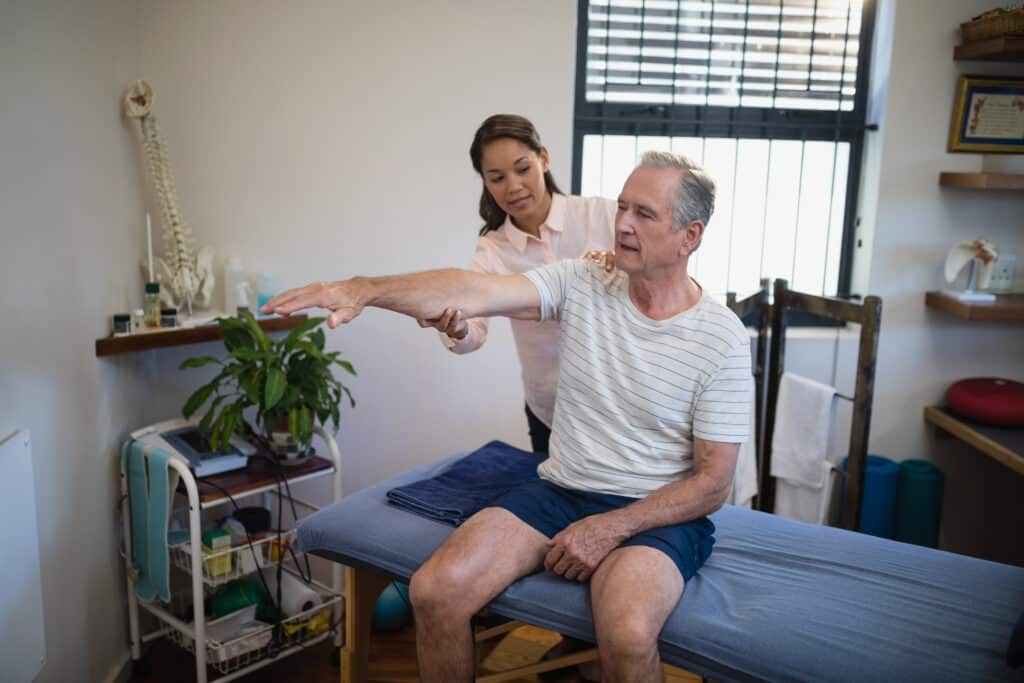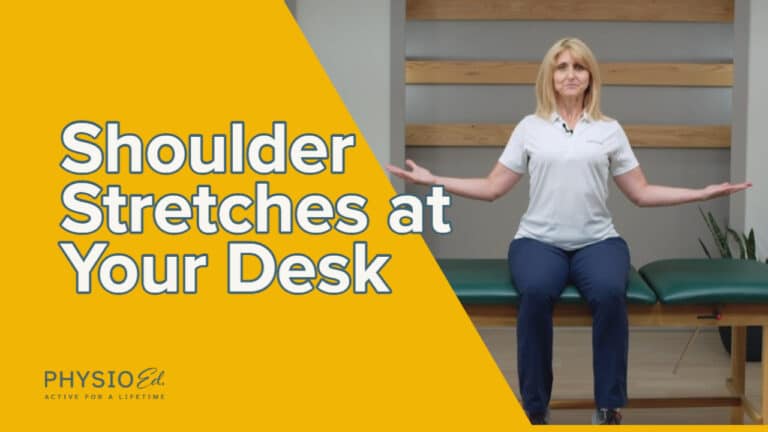Are you struggling with shoulder pain or stiffness? If so, you may have heard of arthroscopic shoulder surgery as a potential treatment option. But what exactly is arthroscopic shoulder surgery, and how can it help you?
Arthroscopic shoulder surgery is a specialized procedure that utilizes a small camera and instruments to address various shoulder problems, including rotator cuff tears, arthritis, and more. It is a minimally invasive approach that offers several advantages over traditional open surgery.
This article will explore common causes of shoulder injuries, the basics of arthroscopic shoulder surgery, standard procedures to expect, and then provide insights into recovery.
Common Causes of Shoulder Problems

As we age, our shoulder joint and surrounding structures become more susceptible to wear and tear, injury, and inflammation. Factors such as age, overuse, and arthritis can contribute to significant shoulder problems that impact daily activities and quality of life.
Age-related changes in the body, such as thinning cartilage, decreased joint lubrication, and reduced tendon and ligament elasticity, can lead to increased friction, inflammation, and damage in the shoulder joint.
Overuse injuries occur when repetitive or strenuous activities stress the shoulder joint. Constant stress can lead to inflammation, irritation, or tissue damage that may not heal with rest and good nutrition alone.
Sudden trauma like falls or dislocations can damage the shoulder joint, often requiring medical intervention. Tendon tears, ligament tears, and fractures are typical examples of resulting injuries.
Arthritis, a common condition among older adults, involves progressive joint inflammation and degeneration. While arthritis doesn’t always lead to significant shoulder problems, it can sometimes cause pain, stiffness, swelling, and reduced range of motion.
The symptoms experienced in the shoulder will vary depending on the underlying problem. Common symptoms include pain (dull, sharp, throbbing, or burning), stiffness, swelling, reduced range of motion, weakness, and difficulty sleeping.
What is Arthroscopic Surgery?
This specialized surgery involves making small incisions through which a tiny camera (arthroscope) and surgical instruments are inserted. The camera provides a clear view of the inside of the shoulder joint, allowing the surgeon to diagnose and treat the problem.
During the procedure, the surgeon may repair or remove damaged tissue, repair torn tendons or ligaments, remove bone spurs, or address other issues. The minimally invasive nature of arthroscopic surgery typically results in less pain, more minor scars, faster recovery, and reduced risk of complications compared to open surgery.
Some common examples of arthroscopic shoulder procedures include rotator cuff repair, labral repair, subacromial decompression, and shoulder stabilization. These procedures are tailored to address specific shoulder problems and can significantly improve pain, function, and quality of life.
After arthroscopic shoulder surgery, a comprehensive rehabilitation program is crucial for optimal recovery. Physical therapy is vital in restoring shoulder strength, flexibility, and function. Your physical therapist will guide you through exercises and techniques to gradually regain mobility and stability in your shoulder.
Recovery time can vary depending on the specific procedure and individual factors. Following your surgeon’s and physical therapist’s instructions is essential to ensure a successful recovery.
Common Examples of Arthroscopic Shoulder Surgery
Arthroscopic shoulder surgery is a minimally invasive procedure used to diagnose and treat various conditions that affect the tendons, cartilage, and other soft tissues surrounding the shoulder joint.
As a physical therapist who has worked extensively with older adults, I have seen how various arthroscopic shoulder procedures can significantly improve shoulder function and alleviate pain. Let’s take a closer look at some of these procedures.
Rotator Cuff Repair
One of the most common arthroscopic shoulder surgeries is rotator cuff repair. The rotator cuff is a group of four muscles and tendons that help stabilize the shoulder joint and enable its movement. When the tendons of the rotator cuff become torn or damaged, it can lead to pain, weakness, and limited range of motion in the shoulder.
While minor rotator cuff tears can often be managed with conservative treatments such as physical therapy, more severe tears may require surgical intervention. During arthroscopic rotator cuff repair, a surgeon uses sutures and anchors to stitch the torn tendon back to the bone, restoring its function and stability.
Labrum Repair
This is another common arthroscopic shoulder surgery. The labrum is a fibrous cartilage that surrounds the shoulder socket, helping to keep the ball of the joint in place and providing cushioning. When the labrum becomes damaged, it can cause pain, clicking, or a sensation often described as “catching” or instability in the shoulder joint.
Arthroscopic labrum repair involves removing or repairing the damaged areas of the labrum. The surgeon trims or removes the damaged part of the labrum using specialized tools such as scissors, shavers, or graspers. Sometimes, sutures and anchors may be used to reattach or reinforce the remaining part of the labrum, restoring stability and function to the shoulder joint.
Shoulder Debridement
Shoulder debridement is a procedure commonly used to treat arthritis and bone spurs in the shoulder joint. Arthritis can cause pain, stiffness, swelling, and limited range of motion, depending on the affected areas. Bone spurs are bony projections that can develop due to arthritis and contribute to pain and limited mobility.
Arthroscopic shoulder debridement involves cleaning out and smoothing the damaged surfaces of the shoulder joint. The surgeon uses specialized tools to remove damaged tissue and smooth the joint surfaces. In some cases, additional procedures, such as tendon repair, may be performed simultaneously to address any other issues.
These are just a few examples of common arthroscopic shoulder surgeries that can help improve shoulder function and alleviate pain. It’s essential to consult with a qualified orthopedic surgeon to determine the most appropriate treatment plan based on your specific condition and needs.
Recovering from arthroscopic shoulder surgery can vary depending on several factors, including the type of surgery, age, health condition, and individual response to the procedure. Let’s take a closer look at the stages of recovery to give you a better understanding of what to expect.
What to Expect During Recovery

The First Few Days
In the immediate aftermath of surgery, you may experience pain, numbness, or tingling in your arm. Your healthcare provider will prescribe medication to help manage your discomfort. Following their instructions on icing and elevating your shoulder is essential to reduce swelling and inflammation.
Most patients can go home the same day or the following day after surgery. You may need to wear a shoulder sling for protection and support, change your dressings regularly, and keep your incisions clean.
The First Few Weeks
During this period, you will begin a physical therapy program as directed by your surgeon. Physical therapy will start with gentle exercises to prevent stiffness and promote healing in your shoulder. These exercises may include passive range of motion, where someone else moves your arm for you.
Alternatively, your physical therapist may recommend using an ‘active-assisted’ range of motion using your other arm or a device as an aid or isometric exercises involving contracting your muscles without moving your joint.
Over time, you will gradually progress to more challenging exercises to increase your range of motion and strength. These may include active range of motion exercises — where you move your arm by yourself — as well as stretching or using resistance bands.
Over the course of your physical therapy protocol, you will also learn how to perform daily activities with your shoulder safely. During this phase, you’ll gradually taper the use of your sling as your shoulder becomes stronger.
I have observed that the bulk of recovery occurs during these first few weeks. Depending on the specific surgery performed, it is often possible to comfortably return to some of your everyday activities within 4-6 weeks after surgery.
The First Few Months
During this phase, you will continue with your physical therapy program and gradually resume your normal activities as tolerated by your shoulder. You will practice many of the movements you were able to do before surgery or those that the injury may have limited.
Some individuals may still experience pain or stiffness in their shoulder during this period, which is normal and should improve over time. Consistency with your exercise program and avoiding pushing yourself too hard is critical for long-term success.
It’s important to note that recovery from arthroscopic shoulder surgery can vary among individuals. Factors such as compliance with instructions and physical therapy, lifestyle habits, and support systems can all influence the outcome.
While everyone’s recovery journey is unique, arthroscopic shoulder surgery is generally considered to have a more straightforward recovery process compared to older surgical techniques. Before considering shoulder surgery, discussing all treatment options with your doctor and physical therapist is always recommended.
Key Takeaways
- Arthroscopic shoulder surgery is a minimally invasive procedure that can diagnose and treat various shoulder problems in older adults, such as rotator cuff tears, shoulder instability, and complications from arthritis.
- Arthroscopic shoulder surgery has many benefits over traditional open surgery, such as smaller incisions, less pain, faster recovery, and lower risk of complications.
- Arthroscopic shoulder surgery involves making small incisions around the shoulder, inserting an arthroscope (a small camera) and surgical instruments through the incisions, viewing the inside of the shoulder joint on a monitor, and repairing or removing damaged tissues or structures.
- Arthroscopic shoulder surgery serves different purposes, such as rotator cuff repair, labrum repair, and shoulder debridement.
- The recovery process after arthroscopic shoulder surgery varies depending on many factors. It usually takes several weeks to months to recover, and following the instructions given to you by your care team is very important for success.
References
- Osteoarthritis. National Institute on Aging (NIH).
- Farmer KW, Wright TW. Shoulder arthroscopy: the basics. J Hand Surg Am. 2015;40(4):817-821. doi:10.1016/j.jhsa.2015.01.002
- Mancini MR, Horinek JL, Phillips CJ, Denard PJ. Arthroscopic Rotator Cuff Repair: A Review of Surgical Techniques and Outcomes. Clin Sports Med. 2023;42(1):81-94. doi:10.1016/j.csm.2022.08.004
- American Academy of Orthopaedic Surgeons. (2021). Arthroscopy of the Shoulder Joint. Retrieved from https://orthoinfo.aaos.org/en/treatment/arthroscopy-of-the-shoulder-joint/
- American Academy of Orthopaedic Surgeons. (2016). Arthroscopy. Retrieved from https://orthoinfo.aaos.org/en/treatment/arthroscopy/






